In some places in the world, often near plate boundaries, there is magma (hot molten rock) very near to the Earth’s surface. This causes other volcanic features such as geysers and hot springs, called geothermal features. The word comes from geo, meaning the Earth, and thermal, meaning heat.
Water from the Earth’s surface trickles down through holes and cracks in the land. Geothermal features are almost always caused by magma that affects underground water.
The most spectacular geothermal feature is the geyser. This is a fountain of steam and water that erupts from holes in the ground. Vents (holes) called fumaroles, where steam escape gently, are more common. Geysers and fumaroles may also give out carbon dioxide and sulfurous fumes.
Hot water can also mix with cooler water to create a hot spring, or with mud to form a bubbling mud hole. Water becomes heated in underground rocks to a temperature above body heat. Some hot springs can be twice this hot. Many are rich in minerals. For centuries, people have believed that bathing in these mineral-rich springs is good for health. The first experiment on the opposite page shows you how to make a geyser using air pressure to force out water. Blowing into the top of the bottle increases the air pressure there. This forces the colored water out of the bottle through the long straw. In the second project, you can create a mud hole and discover the sort of bubbles that form in them.
GEYSER ERUPTION
YOU WILL NEED
Nonhardening modeling material, 3 bendable straws, pitcher, food coloring, large plastic bottle, large jar.
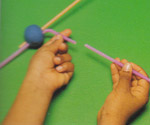
STEP 1
Make two holes in a little ball of modeling material and push two bendable straws through it, as shown. Push another straw through the end of one of the first two straws.
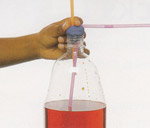 STEP 2
STEP 2
Pour water into the pitcher and add the coloring. Then pour it into the bottle. Push the stopper into the neck, so that the elongated straw dips into the colored water.
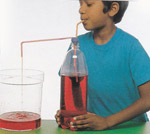 STEP 3
STEP 3
Place the jar under the other end of the elongated straw, and blow into the other straw. Water spurts into the jar. If the long straw was upright, the water would spout upward like a geyser.
MUDBATHS
YOU WILL NEED
Cornstarch, cocoa powder, mixing bowl, wooden spoon, measuring cup, milk, pen, oven mitt.
METHOD:
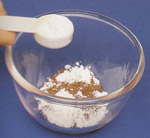
STEP 1
Mix together two tablespoons of cornstarch and two of cocoa powder in the bowl, using the wooden spoon. Stir the mixture thoroughly until it is an even color.
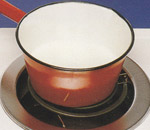 STEP 2
STEP 2
Pour about 10fl oz milk into the pan, and heat it slowly on a stove ring. Keep the ring on a low setting, to make sure the milk does not boil. Do not leave it unattended.
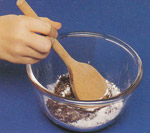 STEP 3
STEP 3
Add some cold milk, bit by bit, to the mixture of cornstarch and cocoa in the bowl. Stir vigorously until the mixture has become a thick smooth cream.
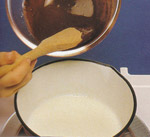 STEP 4
STEP 4
Pour the creamy mixture into the hot milk in the pan. Hold the handle of the pan with the oven mitt, and stir to stop the liquid from sticking to the bottom of the pan.
 STEP 5
STEP 5
If you have prepared your flour and cocoa mixture well, you will now have a smooth, hot liquid that looks something like liquid mud. Soon it will start sending up thick bubbles.
Thick bubbles in the mixture will pop with gentle, plopping sounds. This is exactly what happens in hot mud pools in volcanic areas.
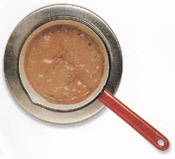
Back to School Projects Main


